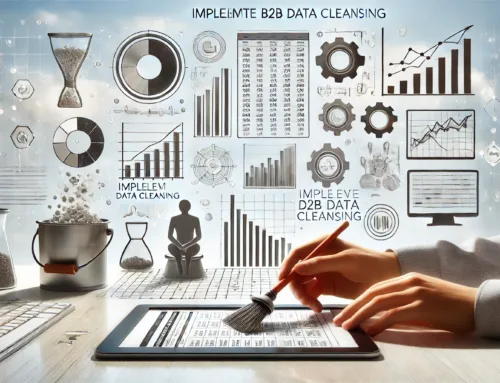When it comes to optimizing B2B data cleansing, understanding the critical steps can make a significant difference in the efficiency and accuracy of your processes. From identifying data sources to implementing advanced cleansing tools, each action plays a crucial role in enhancing your data quality. But what about the common pitfalls to avoid or the innovative strategies that can take your cleansing efforts to the next level? Stay tuned to uncover the essential insights that will transform your approach to B2B data cleansing.
Understand Data Sources
To effectively optimize B2B data cleansing, it is crucial to thoroughly understand your data sources. Start by identifying gaps in your data. Conduct a comprehensive audit to pinpoint missing or outdated information that could impact the quality of your database. By recognizing these gaps, you can prioritize filling them with accurate data to enhance the overall reliability of your database.
Next, validate your data sources. Ensure that the information you collect is coming from trustworthy and reputable channels. Verify the credibility of your sources to minimize the risk of inaccuracies or inconsistencies within your data. Implement validation processes to confirm the authenticity of the data being collected and stored.
Understanding your data sources is fundamental to successful B2B data cleansing. By identifying gaps and validating sources, you lay a solid foundation for improving the quality and integrity of your database. This strategic approach will enable you to make informed decisions and drive more effective marketing and sales initiatives.
Set Data Quality Metrics
When setting data quality metrics for B2B data cleansing, it is imperative to establish clear benchmarks and standards to measure the accuracy and completeness of your database.
- Data Validation: Implement validation checks to ensure that the data entered meets specific criteria and is accurate.
- Quality Assurance: Regularly audit your database to maintain high-quality standards and identify any discrepancies or errors.
- Define Key Performance Indicators (KPIs): Establish KPIs related to data quality, such as error rates, completion rates, and response times.
- Track Progress: Continuously monitor and track the performance of your data cleansing efforts against the defined metrics to gauge improvement and identify areas needing further attention.
Use Advanced Cleansing Software
Establishing clear benchmarks and standards for data quality metrics is just the beginning when it comes to optimizing B2B data cleansing. To enhance your data cleansing efforts, incorporating advanced cleansing software is crucial. Advanced software tools offer features like data standardization, which ensures uniformity in your data format, making it easier to analyze and utilize.
These tools also significantly boost cleansing efficiency by automating processes such as duplicate identification and removal, data validation, and error correction. With advanced cleansing software, you can streamline your data cleansing workflows, saving time and resources while improving the overall quality of your B2B data.
Implement Data Governance
For optimizing B2B data cleansing, implementing data governance is a critical component that ensures the sustained quality and integrity of your business data. Data governance establishes the rules, policies, and procedures for managing data assets effectively. Here are four key elements to consider when implementing data governance:
- Data Validation: Establish robust processes to validate the accuracy and consistency of data inputs. This includes implementing automated validation checks and regular audits to identify and rectify discrepancies promptly.
- Data Classification: Categorize your data based on sensitivity, importance, and usage. By classifying data, you can apply appropriate security measures, retention policies, and access controls to safeguard critical information and comply with regulations.
- Data Ownership: Clearly define roles and responsibilities for data management within your organization. Assign data stewards who are accountable for data quality, accessibility, and security.
- Data Policies: Develop and enforce data governance policies that outline how data should be collected, stored, processed, and shared. These policies should align with industry standards and legal requirements to mitigate risks and ensure compliance.
Regularly Update Records
To optimize B2B data cleansing, updating data accuracy is crucial. By scheduling regular audits, you ensure that your records remain current and reliable. Implementing automated tools streamlines the updating process, enhancing efficiency and accuracy in managing your B2B data.
Update Data Accuracy
Regularly updating your B2B data records is imperative for maintaining data accuracy and relevancy within your organization. To ensure your data accuracy remains high, consider the following key strategies:
- Data Validation: Implement automated tools to validate and cross-check your data regularly. This process helps identify any discrepancies or inaccuracies within your records promptly.
- Error Correction: Develop a systematic approach to address errors as they are identified. This could involve assigning a dedicated team member to oversee error correction tasks promptly.
- Data Enrichment: Continuously enrich your data by adding new information, updating existing records, and enhancing the depth of insights within your database.
- Data Profiling: Utilize data profiling tools to analyze the quality and integrity of your data. By regularly profiling your data, you can detect anomalies or inconsistencies that may impact accuracy.
Schedule Regular Audits
Maintaining the integrity of your B2B data records requires a proactive approach that goes beyond mere validation and error correction. Scheduling regular audits is essential to ensure ongoing data accuracy and validation. By setting up a routine for auditing your data, you can catch inconsistencies, outdated information, or inaccuracies before they impact your business operations.
Regular audits help in maintaining data accuracy by identifying and rectifying errors promptly. Through these audits, you can verify the completeness and correctness of your B2B data, ensuring that your records are up-to-date and reliable. By conducting periodic checks, you can also validate the information stored in your database, confirming that it aligns with the current status of your business relationships.
Implement Automated Tools
For optimal B2B data cleansing, utilizing automated tools is paramount. Automated tools can significantly streamline the process of updating records, ensuring your data remains accurate and up-to-date. Here are four key ways automated tools can help improve data quality:
- Data Validation: Automated tools can quickly validate large sets of data against predefined rules, flagging any discrepancies or errors for further investigation.
- Data Enrichment: By integrating with external databases and sources, automated tools can enrich your existing data with additional information such as contact details, firmographics, or social media profiles.
- Regular Updates: Set up automated schedules to regularly update records in your database, ensuring that any changes or new information are promptly reflected.
- Real-time Monitoring: Some automated tools offer real-time monitoring capabilities, allowing you to track data changes as they occur and take immediate corrective actions if necessary.
Ensure Data Conformity
To optimize your B2B data cleansing process, it is crucial to ensure data conformity by standardizing data formats and verifying data accuracy. By standardizing data formats, you establish a consistent structure that simplifies data management and enhances overall efficiency. Verifying data accuracy ensures that your database is reliable and trustworthy for making informed business decisions.
Standardize Data Formats
Data standardization plays a pivotal role in ensuring the integrity and reliability of your B2B data. To achieve this, it is essential to focus on standardizing data formats. Here are four key strategies to optimize data cleansing through standardization:
- Data Validation: Implement automated validation processes to check the accuracy and completeness of data against predefined rules. This ensures that the data is structured correctly and meets the required standards.
- Format Consistency: Enforce consistent formatting rules across all data fields to avoid discrepancies and errors. This includes standardizing date formats, address structures, and other essential data elements for uniformity.
- Normalization: Transform data into a standard format to eliminate duplicates and inconsistencies. Normalizing data ensures that similar information is represented uniformly throughout the dataset.
- Regular Audits: Conduct periodic audits to review data formatting adherence and identify any deviations. Regular checks help maintain data quality and consistency over time, enhancing the overall reliability of your B2B data.
Verify Data Accuracy
Ensuring data accuracy is paramount for maintaining the reliability and effectiveness of your B2B operations. Data validation and accuracy checks are crucial steps in verifying the integrity of your data. To begin, implement validation processes to ensure that the information entered into your system meets specific criteria. This can involve checking for correct formats, valid entries, and completeness. Accuracy checks should be conducted regularly to identify and rectify any inconsistencies or errors in the data. Utilize automated tools to streamline this process and detect inaccuracies efficiently.
Furthermore, establish data quality metrics to measure the accuracy of your information continually. These metrics can include error rates, completeness percentages, and timeliness of updates. By monitoring these metrics, you can proactively address any data accuracy issues that may arise. Additionally, consider implementing data governance policies to maintain consistent data accuracy standards across your organization. Regularly reviewing and updating these policies will help ensure ongoing data conformity and reliability within your B2B operations.
Frequently Asked Questions
How Can I Handle Data Privacy Compliance During Cleansing?
When handling data privacy compliance during cleansing, you must prioritize data encryption to protect sensitive information. Implement compliance monitoring tools to ensure adherence to regulations. Stay vigilant, as safeguarding data is crucial to maintaining trust.
What Are the Best Practices for Merging Duplicate Records?
When merging duplicate records, employ data matching techniques to identify similarities. Utilize record consolidation strategies, such as prioritizing key fields like email or company name. Ensure data integrity by selecting the most accurate information for retention.
Is It Possible to Cleanse Data Without Losing Valuable Information?
Yes, it is possible to cleanse data without losing valuable information by utilizing data enrichment and data validation techniques. These methods ensure that your data remains accurate, up-to-date, and enriched with additional valuable insights for better decision-making processes.
How Do I Ensure Data Security While Cleansing Sensitive Information?
To ensure data security while cleansing sensitive information, prioritize data encryption and secure deletion methods. Implement access control and confidentiality measures to safeguard against breaches. By integrating these strategies, you can maintain the integrity of your data throughout the cleansing process.
What Measures Can Be Taken to Prevent Data Corruption During Cleansing?
To prevent data corruption during cleansing, ensure data validation and frequent data backups. Maintain data integrity and accuracy by implementing strict validation checks and regular backups. This strategic approach safeguards your data throughout the cleansing process effectively.




